Author: Babywhale, Glendon, Techub News
On the evening of February 13, OpenSea announced the launch of the OS2 public beta version on X, along with the introduction of the platform token SEA, hinting at an upcoming airdrop. Although specific timelines and details have yet to be disclosed, this announcement has undoubtedly stirred the hearts of many veteran players in the crypto space. Within just one hour, the tweet's comments and retweets surpassed a thousand, and community discussions surged.
OpenSea CEO Devin Finzer also tweeted to emphasize, "The OS2 being launched is not just a new product, and SEA is not just a token; it is a completely new OpenSea built from the ground up." There have also been rumors that the new version of OpenSea will reference Blur's trading-centric UI.
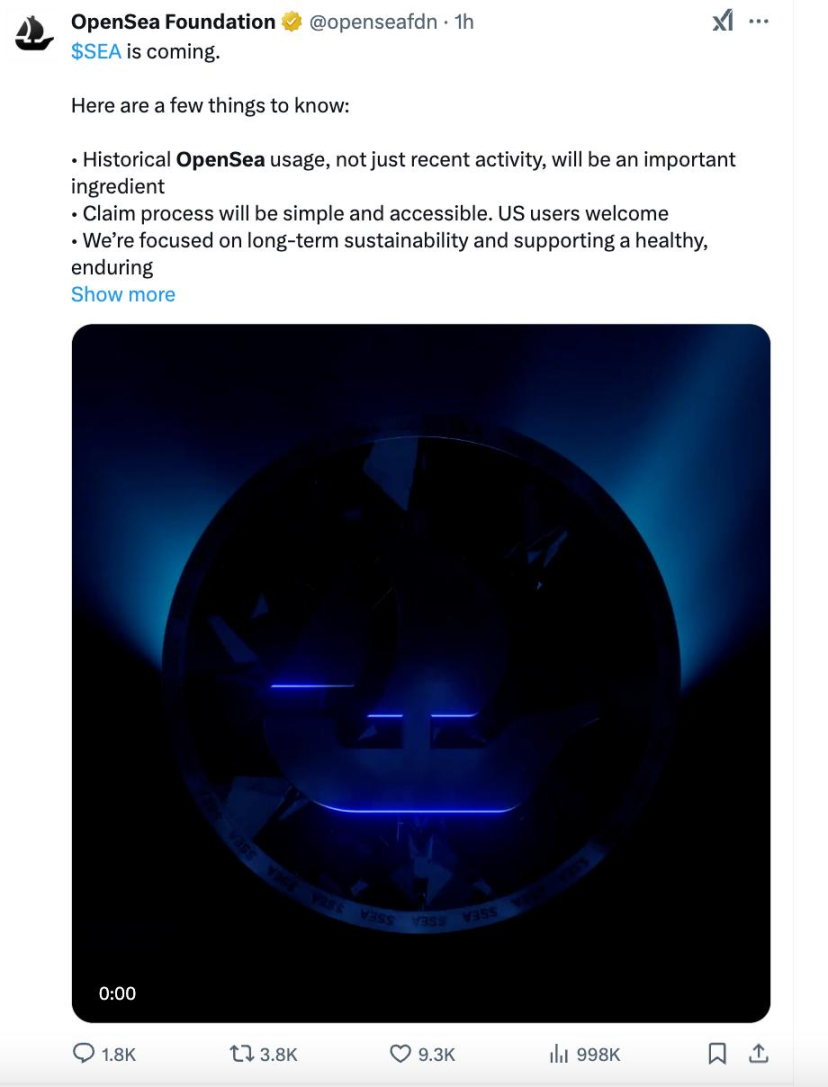
OpenSea is finally issuing a token. If this had happened three years ago, it would have undoubtedly sparked a highly anticipated celebration in the crypto community. However, times have changed; the current crypto space is dominated by MemeCoins, and NFTs have long been "out of fashion." Even more lamentable is that, even if we limit our focus to the NFT sector, OpenSea's glory is no longer present. According to Dune data, OpenSea's trading volume in January was only $195 million, a staggering 96% drop from the peak of $5 billion in early 2022, with annual revenue shrinking to about $33.26 million.
Additionally, data from nftpulse shows that as of the time of writing, OpenSea's market share over the past 30 days has plummeted from 95% in December 2021 to 29%; on the other hand, OpenSea's valuation has also dropped from a peak of $13.3 billion at the beginning of 2023 to around $1.5 billion, and it even reached a point where it was "selling itself."
So, how did OpenSea, once a dominant player in the NFT trading market, end up in this situation?
Let’s review the development history of OpenSea to see how it rapidly rose and how it fell from its throne in the competitive NFT market. Finally, we will discuss the potential impacts of OpenSea's decision to issue a token at this time on the overall NFT market landscape.
Early Days: Surviving in the NFT Wilderness
There is no doubt that OpenSea is a legendary company that started from scratch among Web3 startups, especially during the two years from 2021 to 2022, when the company skyrocketed from obscurity to a valuation of $13.3 billion, firmly sitting at the top of the NFT trading market. However, behind this brilliance lies a dramatic history of market ups and downs. Therefore, I believe that the rise and fall of OpenSea can also be seen as a microcosm of the NFT industry's transition from wild growth to rational competition.
In September 2017, Devin Finzer and Alex Atallah secured seed funding from the well-known venture incubator Y Combinator with their innovative project "Wificoin," which aimed to use cryptocurrency to pay for shared WiFi and had no connection to the NFT space.
However, in November 2017, Dapper Labs officially launched the Ethereum-based game CryptoKitties, sparking a wave of hype. The frenzied bidding pushed the price of CryptoKitties NFT collectibles to 247 ETH, which was about $118,000 at the time.
In the same year, CryptoKitties' founder and CTO Dieter Shirley proposed the concept of NFTs (Non-Fungible Tokens) and facilitated the introduction of the EIP-721 standard that defines NFTs. (Techub News note: EIP-721 was later discussed and improved, officially passing in 2018 to become the current ERC-721 protocol standard.)
The introduction of this standard changed the entrepreneurial direction for Devin Finzer and his partner. They decided to abandon the original "Wificoin" project and created the NFT trading platform OpenSea in February 2018.
According to The Generalist, Devin Finzer stated, "We saw the potential of the NFT market because there was a standard for digital projects, and everything that came after CryptoKitties would adhere to this standard."
At that time, the blockchain and cryptocurrency were still in their early development stages, and the concept of NFTs had not yet become widespread; the entire NFT market was almost a barren land.
Despite this, OpenSea was not the only NFT trading platform at the time. Almost on the same day it launched on Product Hunt, Rare Bits, which claimed to be a "zero-fee crypto asset marketplace similar to eBay," emerged as a more advantageous competitor. Interestingly, OpenSea also described itself as "the eBay of crypto goods." (Techub News note: eBay is an online auction and shopping website that allows people worldwide to buy and sell items.)
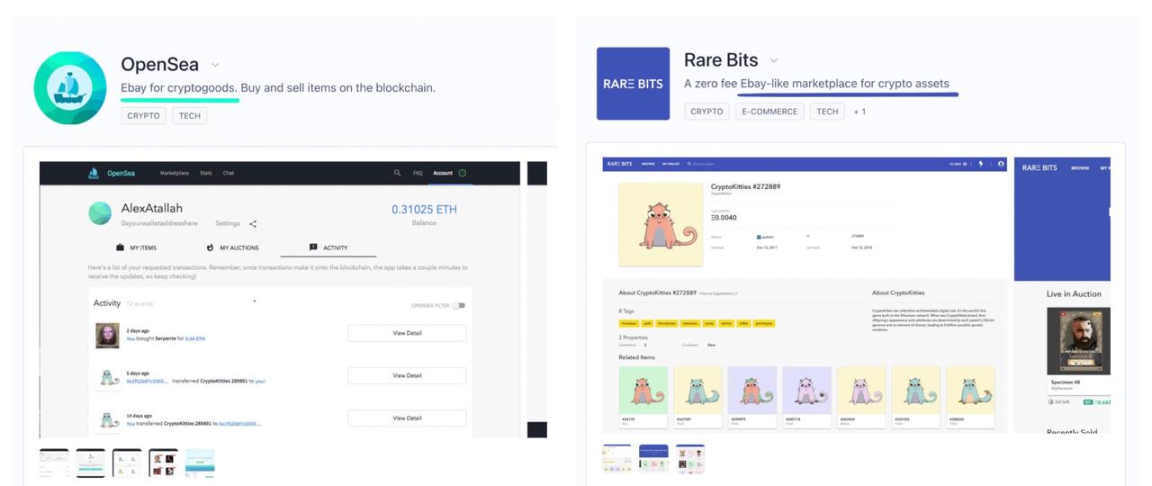
In May 2018, OpenSea raised $2 million from investors including 1confirmation, Founders Fund, Coinbase Ventures, and Blockchain Capital. However, Rare Bits had already secured $6 million in funding a month earlier, with investors including Spark, First Round, and Craft.
From the perspective of VC investment, OpenSea was at a disadvantage, but 1confirmation partner Richard Chen favored OpenSea more, believing that "Rare Bits does not understand NFTs as well as OpenSea. The OpenSea team is more capable and battle-ready, and Devin and Alex have done a great job discovering new NFT projects and pushing them onto OpenSea. Moreover, by the time we invested in April 2018, OpenSea's trading volume was already four times that of Rare Bits."
In addition, the sales strategies of the two companies differed. OpenSea insisted on charging a 1% transaction fee (which later gradually increased to 2.5%) to maintain operations through stable revenue. Rare Bits, on the other hand, adopted a "zero-fee" strategy in 2018 and promised to refund users for Gas fees incurred during transactions, attempting to attract traffic by lowering user costs. This strategy initially attracted some attention and seemed more user-friendly, but it was detrimental to the platform's long-term development. The high operational costs meant that Rare Bits would struggle to survive, especially with the arrival of the "2018 cryptocurrency winter."
During this period, to expand its user base and increase platform trading volume, Rare Bits also attempted to extend its business from NFTs to a broader range of virtual goods trading, such as launching "digital stickers" in collaboration with the anime platform Crunchyroll and exploring trading of non-NFT assets like game items.
In contrast to Rare Bits' diversification, OpenSea remained focused, with its core work always aimed at improving NFT trading.
However, the road before dawn was also tough for OpenSea. The platform's early trading volume remained sluggish, and early projects were limited to a few NFTs like CryptoKitties and CryptoPunks.
According to reports from Titanium Media, in March 2020, the team had only five members, with a monthly trading volume of around $1 million. Based on the 2.5% commission rate at the time, OpenSea's monthly revenue was only $28,000. If it weren't for the $2.1 million "lifeline" injected by strategic investors like Animoca Brands at the end of 2019, this startup might have already disappeared in the industry's winter. As for Rare Bits, it had already shown signs of crisis as early as 2019, and by 2020, the platform completely exited the market.
In hindsight, OpenSea's rise to become the king of the NFT field can be attributed to its focus on core business and streamlined operational decisions. Devin Finzer stated in an interview, "We are willing to develop in this field for the long term, regardless of the current growth trajectory. We want to build a decentralized marketplace for NFTs and hope it can last for 3-4 years."
Time quickly moved to the second half of 2020, and dawn was approaching. This year can be seen as a watershed moment for OpenSea. As the crypto market gradually warmed up in the second half of the year, OpenSea, leveraging its first-mover advantage in the NFT market, began to reap the rewards, with its platform trading volume rapidly climbing. Dune data shows that in October 2020, OpenSea's monthly trading volume reached approximately $4.18 million, a growth of about 66% from $2.46 million in September.
To offer a wider variety of NFT assets and attract broader liquidity, OpenSea began to fully implement its "open market" product strategy.
In December 2020, OpenSea launched a new feature called "Collection Manager," allowing users to mint NFTs without transaction fees (Gas fees borne by buyers). The official referred to this feature as "Lazy Minting," separating on-chain issuance from metadata. Users could upload the metadata of their products to OpenSea for free, and the NFTs would only be minted on-chain as ERC-1155 NFTs when the products were sold for the first time.
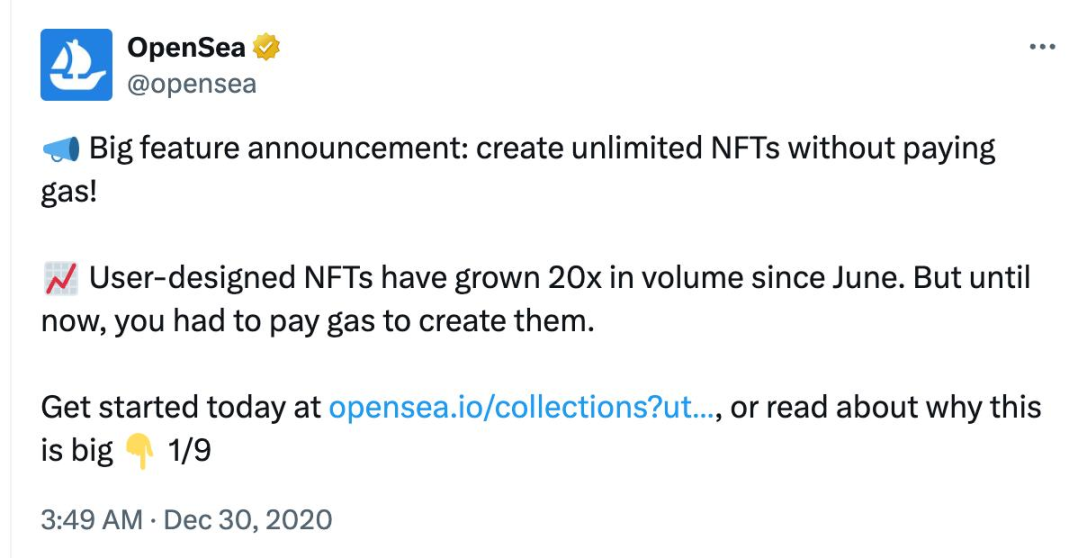
This feature significantly lowered the barrier for creators, and with the characteristic of no review required for listing NFTs on OpenSea, every user can directly mint and issue NFTs on the platform. Beyond this advantage, OpenSea also covers the widest variety of trading categories among similar platforms, including digital avatars, music, domain names, virtual worlds, trading cards, artworks, and various NFT collectibles. Its strategy maximally expands the supply of creators' works, attracting an increasing number of users in both primary and secondary markets.
Objectively speaking, the latent potential of the NFT market contributed to OpenSea's later success, but the rapid emergence of this sector was undoubtedly bolstered by OpenSea's contributions.
In 2021, the crypto market experienced a comprehensive "bull market," and OpenSea, which had been dormant for two years, began to truly shine.
NFTs Experience Phenomenal Surge, OpenSea Reigns with Billions in Monthly Trading Volume
According to Dune data, February 2021 marked the first explosive growth for OpenSea's metrics. On February 2, OpenSea's daily trading volume exceeded $5 million, while the total trading volume for January was just over $7.5 million. Ultimately, OpenSea's trading volume for the entire month of February approached $95 million, growing more than tenfold month-over-month.
Starting from early 2021, a large number of commemorative NFTs began to be issued on OpenSea, with bands, entertainment stars, sports celebrities, and well-known artists launching their own NFTs. Many famous brands also started to release commemorative NFTs or utilize NFTs for user loyalty programs. It can be said that the NFT phenomenon, which began with CryptoKitties, first connected Web3 with traditional industries and introduced many who were previously unfamiliar with crypto to a brand new "species."

NFT series launched by Budweiser
As the largest NFT trading platform, OpenSea finally welcomed the arrival of the windfall. Data shows that in March 2021, the trading volume on OpenSea first broke the $100 million mark, exceeding $300 million in July, and in August, this figure grew more than tenfold month-over-month to $3.44 billion. It was also in March that OpenSea completed a $23 million funding round led by a16z, with many angel investors, including Mark Cuban, participating in this round of investment.
Although NFTs had actually begun to develop rapidly since early 2021, with the floor price of the CryptoPunks series rising from single-digit ETH at the beginning of the year to over ten ETH by mid-year, the main narrative of the market in the first half of 2021 still revolved around DeFi. At that time, people's attention had not fully shifted to NFTs. The reasons for this included the continued rise in DeFi's popularity and the absence of tradable targets and concepts in the NFT space.
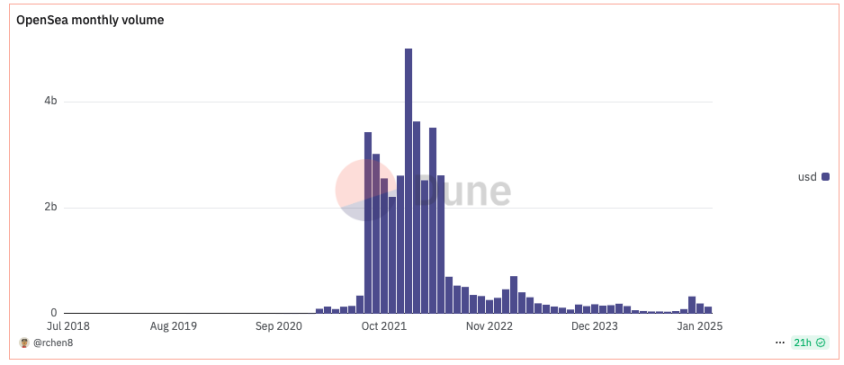
As the second half of the year began, the emergence of a series of PFPs represented by BAYC ignited market enthusiasm, and NFTs were regarded as another phenomenal concept following DeFi. With the surge in NFT trading, OpenSea's monthly trading volume consistently remained at high levels, even surpassing $5 billion in January 2022. Nate Chastain, OpenSea's product lead, tweeted at the end of August 2021 that the company had only 37 employees, and that month, OpenSea's revenue from transaction fees alone exceeded $80 million, with an average contribution of over $2 million per person, which is an extraordinarily impressive figure in any industry.
Before the end of 2021, OpenSea spent most of its time accelerating its growth. During this period, aside from Nate Chastain's departure due to an insider trading scandal, there were virtually no other negative news stories about OpenSea. Other NFT trading platforms, even with significant funding, could not shake OpenSea's position, and nearly all NFT trading platforms' products referenced OpenSea to some extent.
Challengers Lurk, OpenSea "Betrays" Web3 with IPO Plans?
Amidst this prosperous era, a turning point quietly approached, beginning with rumors of OpenSea's IPO…
In early December 2021, Bloomberg reported that Lyft's CFO Brian Roberts would join OpenSea as CFO, and he indicated that he was planning an IPO for OpenSea. This was initially an ordinary piece of news, but it sparked some discussions within the Web3 community, with many believing that OpenSea should issue a token to reward its users, which is what a Web3 project should do.
Perhaps feeling some pressure, two days later, Brian Roberts personally clarified that there were currently no IPO plans, stating, "There is a big difference between thinking about what an IPO will ultimately look like and actively planning for an IPO. We have no plans for an IPO; if we did, we would seek community involvement."
This somewhat ambiguous statement not only failed to alleviate the community's concerns but instead strengthened the belief that OpenSea would eventually go public, as he did not mention anything about issuing a token.
Had OpenSea decided to issue a token at that time, the NFT trading platform sector might not have had the subsequent exciting stories. It was the "selfish" decision to pursue an IPO that opened a crack in the previously unassailable wall.
At that time, OpenSea held over 90% of the NFT trading market on Ethereum, and after its stance against issuing a token became known, some entrepreneurs found an opportunity and quickly launched NFT trading platforms that issued tokens. LooksRare was one of them; although it was not the first project to launch a "vampire attack" on OpenSea, its emergence had a significant impact after OpenSea announced its IPO plans.
On January 10, 2022, LooksRare officially launched, stating that users who traded at least 3 ETH on OpenSea could list an NFT on LooksRare to receive an airdrop. Additionally, users could stake the LOOKS tokens received from the airdrop to share in all platform trading fees. Just two days after its launch, LooksRare's daily trading volume exceeded that of OpenSea, and by January 19, 2022, its seven-day trading volume was more than three times that of OpenSea.
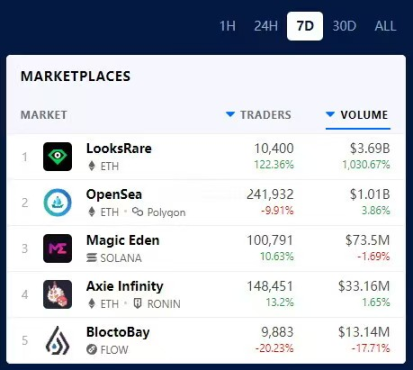
Once the crack was opened, the market realized that OpenSea was not invincible, and everyone began to showcase their abilities. In February 2022, platforms like X2Y2, Element (focused on BNB Chain), Zora (focusing on high-end art NFTs), and Magic Eden (focused on the Solana NFT market) emerged, continuously eating into OpenSea's existing market and potential expansion areas. While it may be an exaggeration to say that arrogance played a role, it was indeed a significant strategic misstep for OpenSea not to take precautions during its peak.
Despite this, OpenSea's market influence remained difficult to shake. As we entered the second quarter of 2022, on one hand, Yuga Labs was about to issue the APE token, and on the other hand, trading of "blue-chip NFTs" like Moonbirds and Doodles remained active. As the most liquid NFT trading market, OpenSea still held the lifeblood of the NFT market.
The main culprit responsible for changing the entire NFT sector or causing the NFT market crash quietly emerged at this time, fundamentally altering the stereotypical impression of what the NFT market should look like.
Blur Emerges, NFT Market's "Top Spot" Changes Hands
At the end of March 2022, Blur announced it had completed $11 million in funding. At that time, many people might have wondered why a new NFT trading platform was emerging, but when Blur officially launched at the end of October, it delivered a shocking blow to everyone.
With a completely different UI, it clearly defined that listing, bidding, and trading would all come with airdrops, and the airdrops were essentially "treasure chests" with unknown amounts of tokens. The UI designed purely for trading, along with the clear yet ambiguous airdrop expectations, allowed Blur to excel in product and gameplay design. Although many initially criticized Blur's UI as difficult to use, once accustomed to it, users found that this design was indeed much more user-friendly for buying and selling compared to OpenSea. To put it metaphorically, if OpenSea is the e-commerce platform for NFTs, then Blur is the exchange for NFTs.
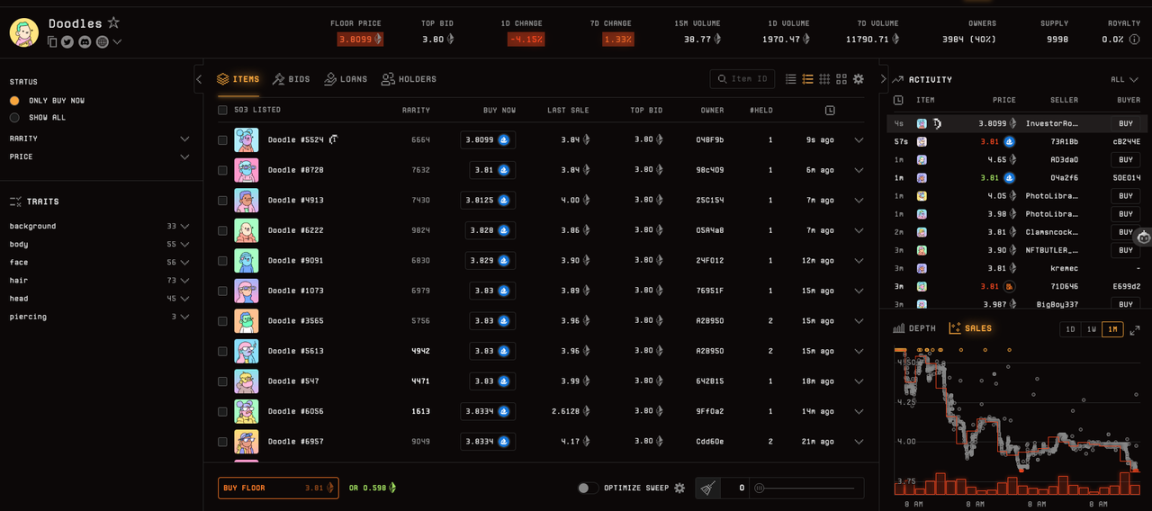
Prices are listed from low to high, with real-time trading and transaction price distributions displayed on the right. This user-friendly UI design, combined with airdrop expectations, led to a significant influx of funds into Blur. Previously, many NFT trading platforms attracted traffic in the short term through tokens, but OpenSea's market share in trading volume had not been challenged in monthly or quarterly data. However, with the emergence of Blur, OpenSea's share of trading volume fell back to below 50% just a week ago.
However, it is precisely because of this that large funds gained the ability to manipulate the market, frantically buying and selling. Coupled with the fact that the Crypto market had already entered a deep bear phase, the sight of large funds recklessly brushing for airdrops caused many NFT prices to be nearly crushed, leading retail investors to lose interest in NFTs. After Bitcoin had fallen to around $20,000, the "last gatekeeper" of crypto assets also quietly exited the scene. The collapse of the NFT market, combined with the rise of the new king Blur, turned OpenSea into collateral damage.
At the beginning of 2022, OpenSea completed a $300 million Series C funding round with a valuation of $13.3 billion. By early 2024, just two years later, OpenSea's CEO had already admitted to considering a sale. In this round of Bitcoin's "one-man bull market," aside from the airdrop-anticipated Pudgy Penguins, many previously blue-chip NFTs had seen their floor prices plummet to distressing levels. For OpenSea, failing to make changes could lead to years of hard work being handed over, which was certainly not what they wanted to see.
Therefore, OpenSea has decided to launch the platform token SEA, partly as a self-rescue measure in response to the continuous decline of its business; on the other hand, this former king may also harbor a bit of unwillingness and ambition to return to the top. So the question arises: could OpenSea's issuance of a token change the competitive landscape of the NFT market?
Recent Trading Volume Surge, Can OpenSea Reshape the NFT Market Competition?
Undoubtedly, OpenSea's issuance of a token and the launch of the OS2 public beta version are most likely to impact Blur. As a powerful competitor that has disrupted OpenSea's position, Blur has shown signs of decline as the Crypto market has also trended downward. However, as of the time of writing, its trading market share over the past 30 days still exceeds 44%, firmly holding the top spot in the NFT market.
In addition to the unique product UI and gameplay design mentioned above, Blur initially attracted a large number of users with its Bid Airdrop (bidding reward tokens) and zero-fee model. It conducted multiple airdrops in 2023 to seize market share, as evidenced by the data:
On February 15, 2023, Blur conducted its first quarter airdrop of 360 million BLUR tokens, which accounted for 12% of the initial total supply and was released immediately. According to a report by Glassnode, after the BLUR token airdrop, Blur's market share surged, with its NFT trading volume market share jumping from 48% to 78%, while OpenSea dropped by 21%.
On February 23, 2023, Blur launched its second quarter airdrop of 300 million BLUR tokens. This airdrop directly propelled Blur's trading volume significantly beyond that of OpenSea. DappRadar data showed that on February 22, 2023, BLUR's trading volume reached approximately $108 million, while OpenSea's was only $19.27 million during the same period.
To a certain extent, Blur's two large token airdrops played a crucial role in breaching OpenSea's "moat." As the saying goes, "an eye for an eye," in the current NFT market, which has yet to warm up, if OpenSea's SEA token attracts users through airdrops or staking rewards, it is very likely to replicate this strategy. It could even emulate the "vampire attacks" launched by past "OpenSea killers" like LooksRare and x2y2 to compete for core users.
In fact, since OpenSea confirmed it would conduct an airdrop, it has sparked much anticipation and discussion among Twitter users, with many believing this will be one of the largest airdrops of the year.
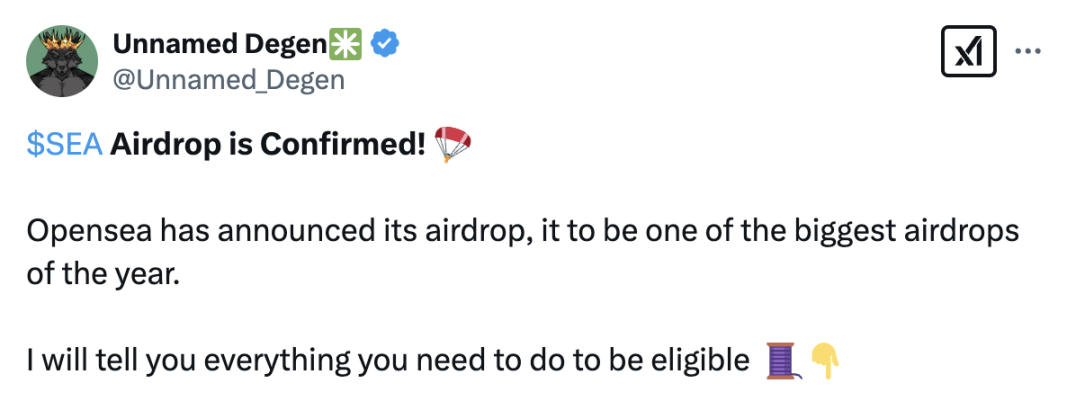
Additionally, regarding transaction fees, OpenSea's recently launched OS2 beta version has reduced market fees to 0.5%, with transaction fees set at 0%. This directly competes with Blur's zero-fee model. Once SEA is launched, OS2, with its combination of "low fees + token incentives," is likely to construct a very flexible competitive strategy.
Objectively speaking, most users are essentially profit-driven. If the SEA token's reward mechanism is more attractive, and considering that some existing users of Blur originally came from OpenSea, it is not impossible for these users to return to OpenSea. However, Blur's "moat" lies in its faster transaction speed and higher gas efficiency compared to OpenSea, which still gives it a technical advantage in the short term.
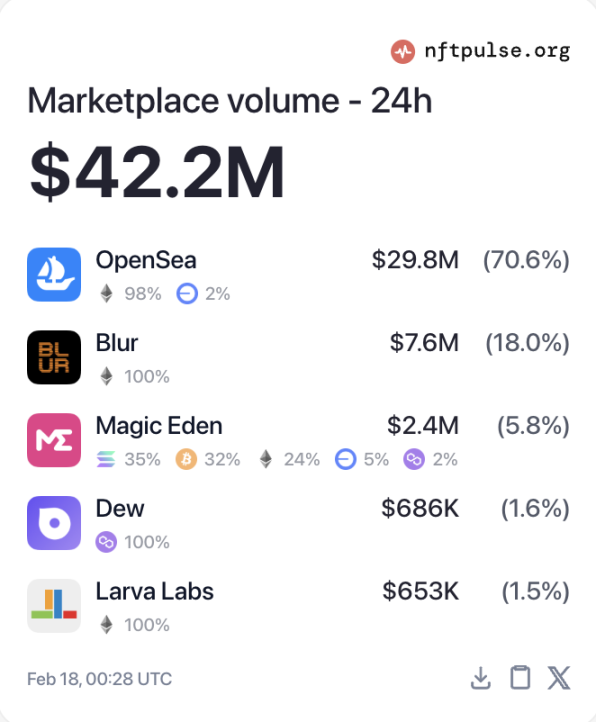
The market has already reacted to the news of the token issuance. According to nftpulse data, as of the time of writing, OpenSea's daily trading volume has reached approximately $29.8 million, with its trading share soaring to 70.6% of the total daily trading volume.
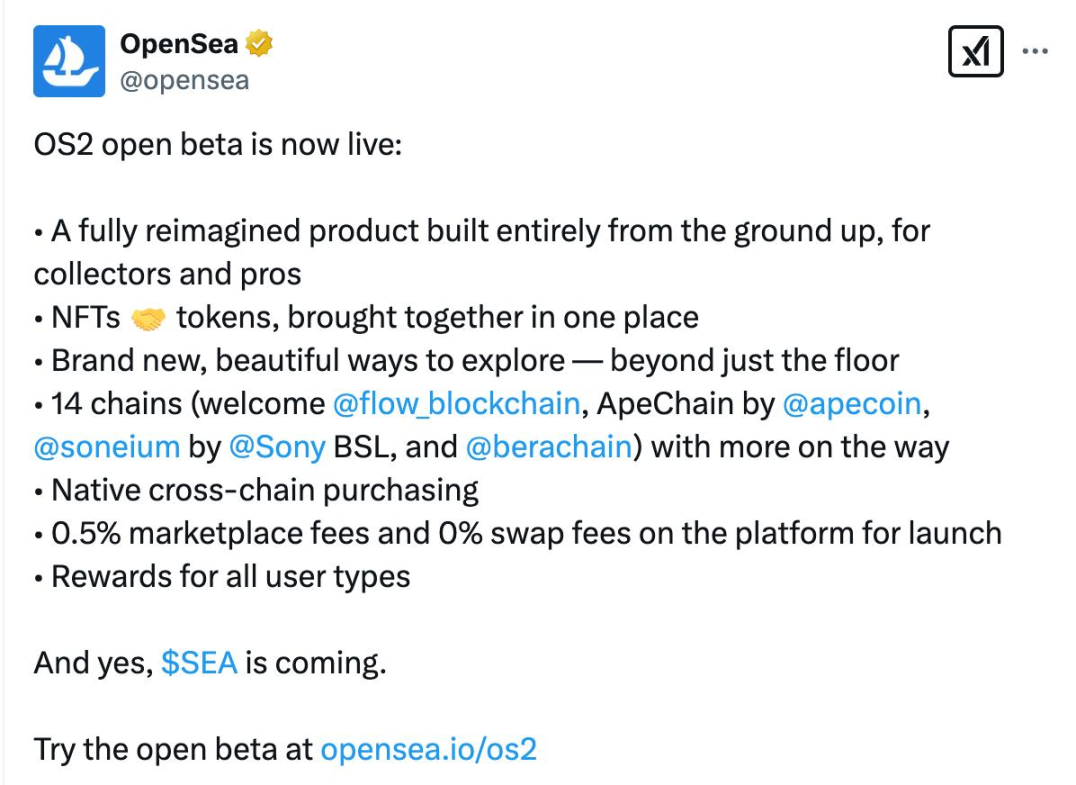
For the entire NFT market, OpenSea's launch of the SEA token is undoubtedly a positive development. In addition to significantly stimulating NFT trading volume in the short term, OpenSea also mentioned in a tweet that OS2 now supports cross-chain trading across 14 chains, including Flow, ApeChain, and Soneium. This raises the question of whether the SEA token could become a universal token for a multi-chain NFT ecosystem, thereby promoting the development of NFT markets on Ethereum's side chains (such as Solana). This is something to look forward to.
However, from another perspective, the intense competition between OpenSea and Blur will also squeeze the survival space of second-tier platforms like LooksRare and X2Y2. Blur will likely not sit idly by as its former rival makes a comeback; it may introduce more token application scenarios or further incentivize user loyalty through token rewards. Additionally, Magic Eden, also a latecomer, should not be underestimated. With its dominant position on Bitcoin and Solana chains, its total market trading volume reached $3.2 billion in the past year, accounting for over 30%, second only to Blur's $3.8 billion (approximately 36%), while OpenSea's trading volume over the past year was only $1.2 billion, accounting for less than 12%.
In summary, I believe that OpenSea's SEA token is not only key to the platform's self-rescue but may also become a driving force to help the NFT market emerge from its sluggish state. In the long run, the competition between OpenSea and Blur will push the NFT sector towards more complex financialization and multi-chain development. Whether OpenSea can reclaim its dominant position will depend on the performance of the SEA token after its launch. We will have to wait and see!
免责声明:本文章仅代表作者个人观点,不代表本平台的立场和观点。本文章仅供信息分享,不构成对任何人的任何投资建议。用户与作者之间的任何争议,与本平台无关。如网页中刊载的文章或图片涉及侵权,请提供相关的权利证明和身份证明发送邮件到support@aicoin.com,本平台相关工作人员将会进行核查。




